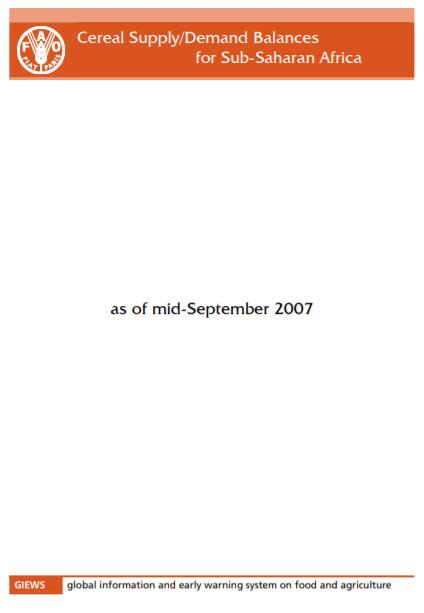
Cereal supply and demand balances for sub-Saharan African countries - No.3, September 2007
20/09/2007
The FAO/GIEWS Country Cereal Balance System (CCBS) is a database of annual supply and utilization balances for main cereals, covering all countries of the world. It has been maintained by FAO/GIEWS since 1980 and is updated on a continual basis. This statistical report, which is a subset of CCBS data, presents the current-year cereal supply and demand balances for all sub-Saharan African countries, highlighting cereal import and food aid requirements of each country. This report is complement ary to the FAO/GIEWS report Crop Prospects and Food Situation and is published four times a year, with the same schedule.
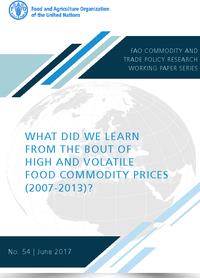
FAO Commodity and Trade Policy Research Working Paper Series No. 54
13/09/2007
his research paper looks at the crisis in international agricultural markets during the last decade and draws out some lessons. Although crop prices continue to be volatile, the bout of high prices/high volatility ended by 2015. The initial rapid rise of prices was not predicted, and surprised both market players and the international community more broadly. Considerable policy attention was focused on the crisis – by the UN broadly, by FAO and its members, by G20 heads, agricultural groups, an d national governments.
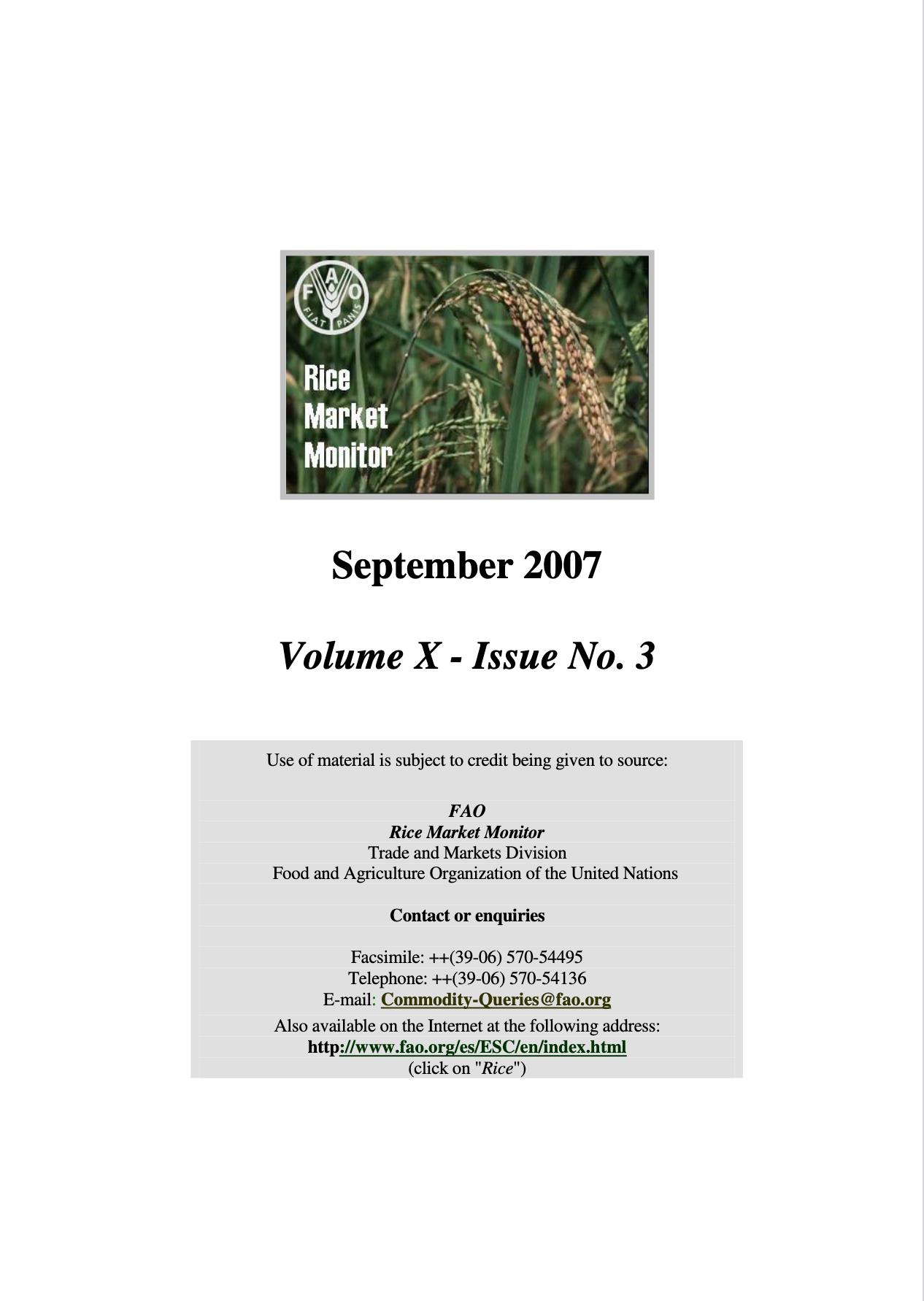
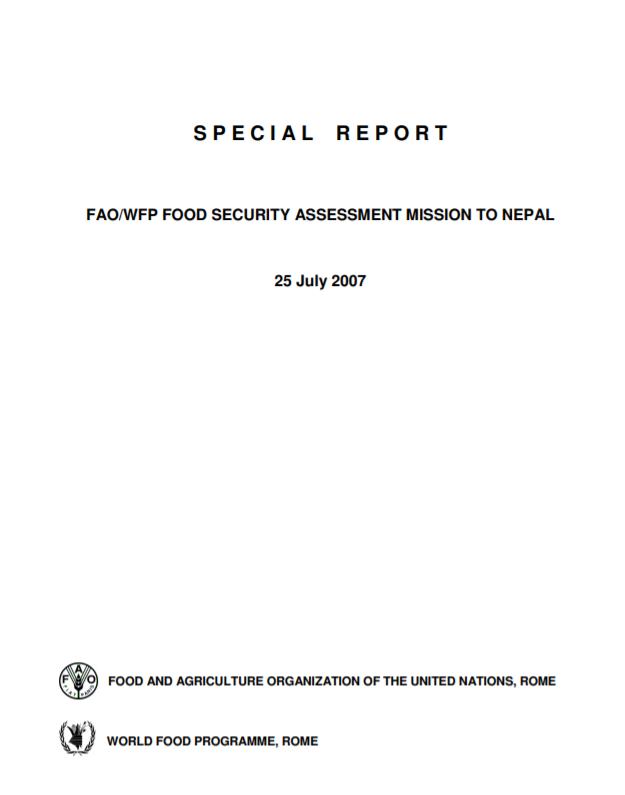
Special Report - FAO/WFP Food Security Assessment Mission to Nepal
25/07/2007
At the request of the Ministry of Agriculture and Cooperatives of Nepal (MoAC), a joint FAO/WFP Food Security Assessment Mission visited the country from 20 March to 8 April 2007. The overall objective of the assessment was to have a better understanding of chronic and transitory (disaster-affected, shortterm) food insecurity by assessing the 2007 winter cereal crops, current food availability, market access and food utilization situation in the country at national, sub-national and household levels so that appropriate actions can be taken by the government and the international community to minimize the impact of potential food insecurity.
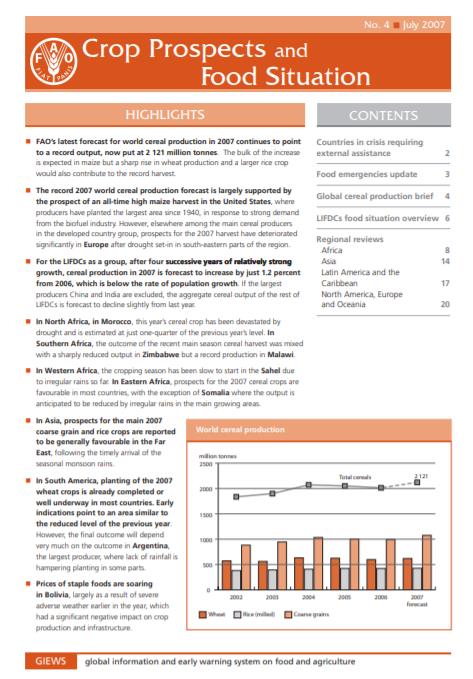
Crop Prospects and Food Situation #4, July 2007
05/07/2007
FAO’s latest forecast for world cereal production in 2007 continues to point to a record output, now put at 2 121 million tonnes. The bulk of the increase is expected in maize but a sharp rise in wheat production and a larger rice crop would also contribute to the record harvest. The record 2007 world cereal production forecast is largely supported by the prospect of an all-time high maize harvest in the United States, where producers have planted the largest area since 1940, in response to strong demand from the biofuel industry. However, elsewhere among the main cereal producers in the developed country group, prospects for the 2007 harvest have deteriorated significantly in Europe after drought set-in in south-eastern parts of the region. For the LIFDCs as a group, after four successive successive years of relatively strong years of relatively strong years of relatively strong growth, cereal production in 2007 is forecast to increase by just 1.2 percent from 2006, which is below the rate of population growth. If the largest producers China and India are excluded, the aggregate cereal output of the rest of LIFDCs is forecast to decline slightly from last year.
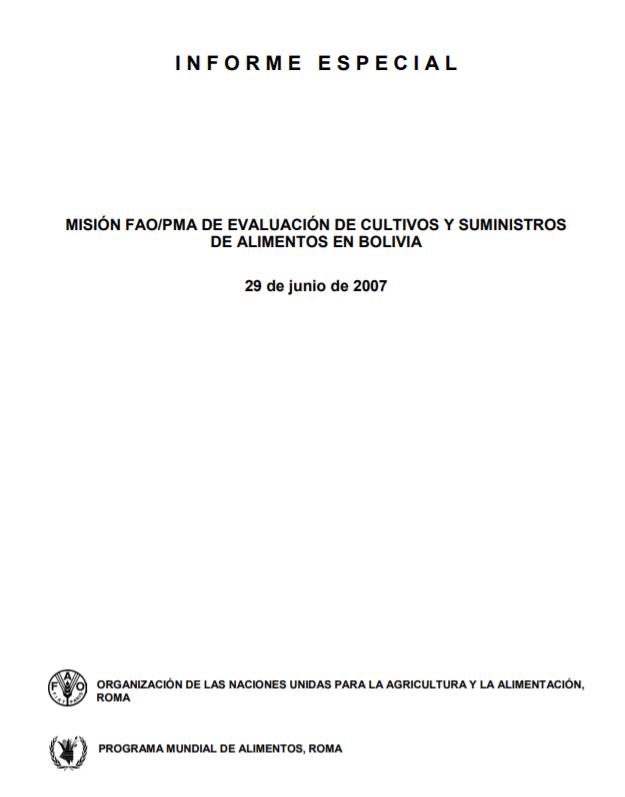
Informe Especial - Misión FAO/PMA de Evaluación de Cultivos y Suministros de Alimentos en Bolivia
29/06/2007
Una Misión conjunta FAO/PMA de evaluación de los cultivos y suministro de alimentos visitó Bolivia del 9 al 28 de abril de 2007 a fin de evaluar la producción de cereales y tubérculos de 2007, que fue severamente afectada por una serie de eventos climáticos adversos tales como sequías, heladas e inundaciones, y estimar las necesidades de importación para la campaña comercial 2007/08 (julio/junio). La Misión mantuvo estrecha colaboración con dos ejercicios de evaluación que se desarrollaron simultáneamente: una misión multisectorial de la Comisión Económica para la América Latina y el Caribe (CEPAL) que realizó una evaluación y valoración de las pérdidas en los diversos sectores económicos y una misión conjunta de FAO/OIT que realizó una evaluación rápida del impacto que los eventos climáticos desfavorables tuvieron en los medios de vida de la población local. Además un experto del Servicio de Operaciones de Emergencia del Departamento de Cooperación Técnica de la FAO (TCEO) colaboró con la Misión a fin de preparar un listado preliminar de proyectos de urgencia y de rehabilitación del sector agropecuario boliviano.
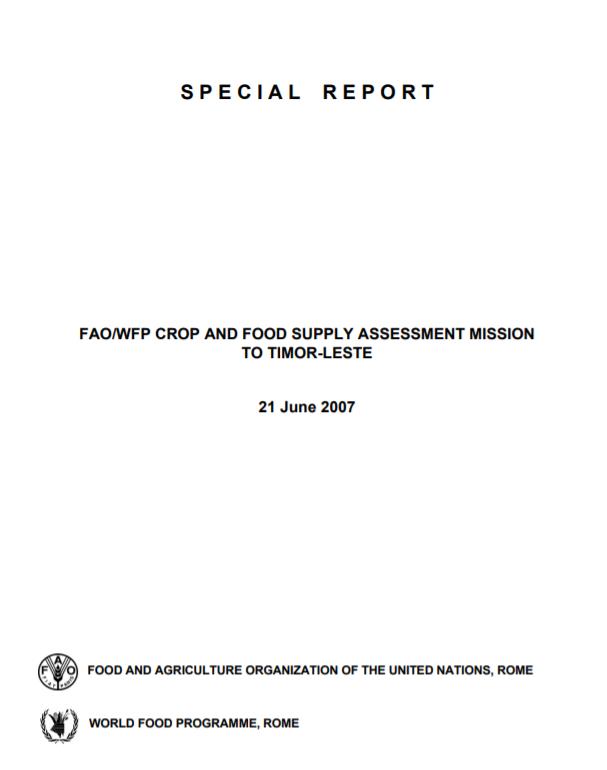
Special Report - FAO/WFP Crop and Food Supply Assessment Mission to Timor-Leste - 21 June 2007
21/06/2007
A FAO/WFP Crop and Food Supply Assessment Mission visited Timor-Leste from 17 March to 8 April 2007 to review and analyze the food supply and demand situation in the context of the country’s macro-economic situation, and to forecast import requirements in the light of potential food needs in marketing year 2007/08 (April/March), with particular attention to the needs of the most vulnerable groups. The team also carried out general analysis regarding food security policy in the country, as a rice crisis had just erupted; this provided lessons on what not to do in similar future circumstances. Emphasis was placed on the appropriate institutional set-up needed to achieve consistency in food security, as well as sustainable development over the longer term, especially through a rehabilitation of the agriculture sector.
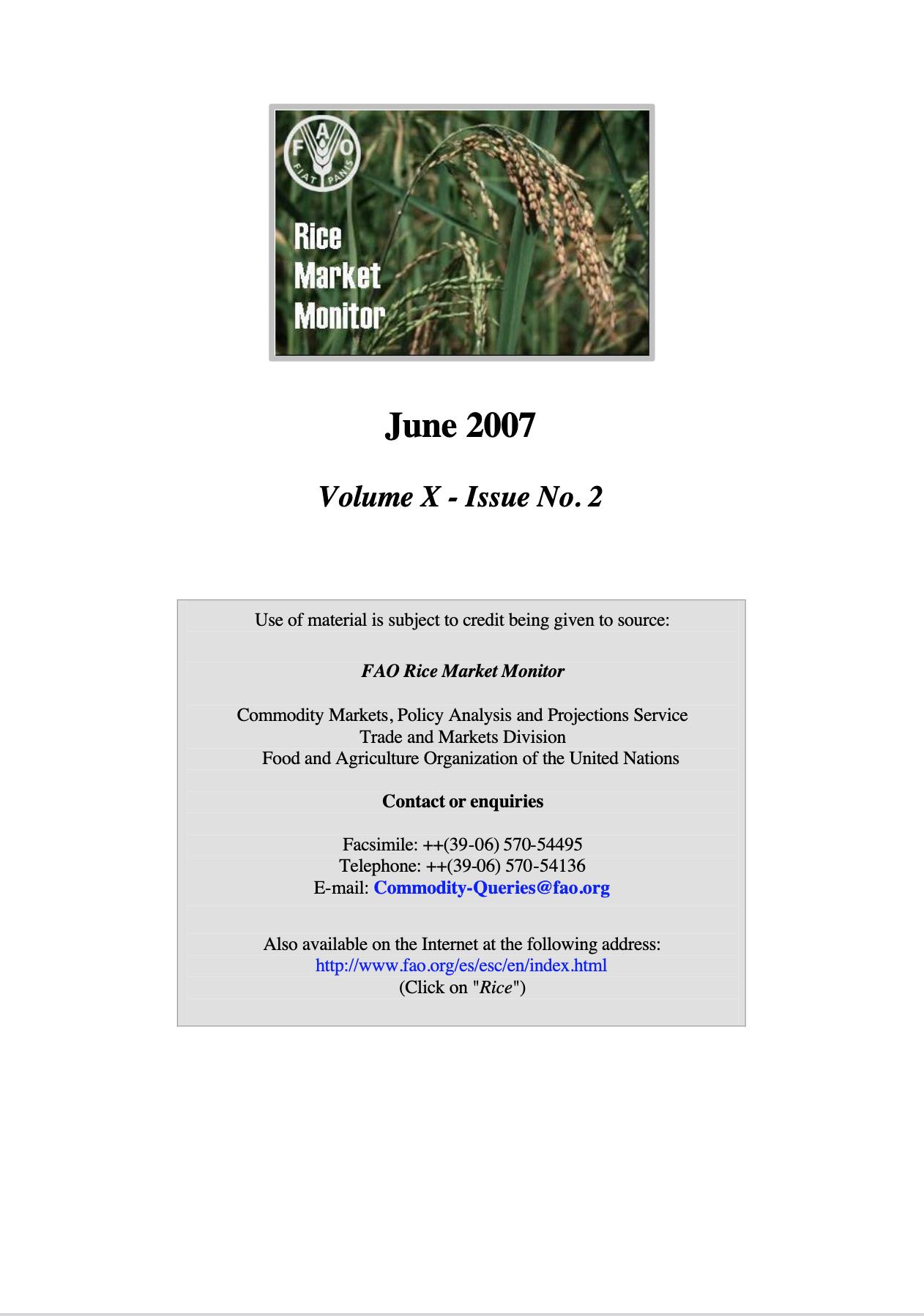
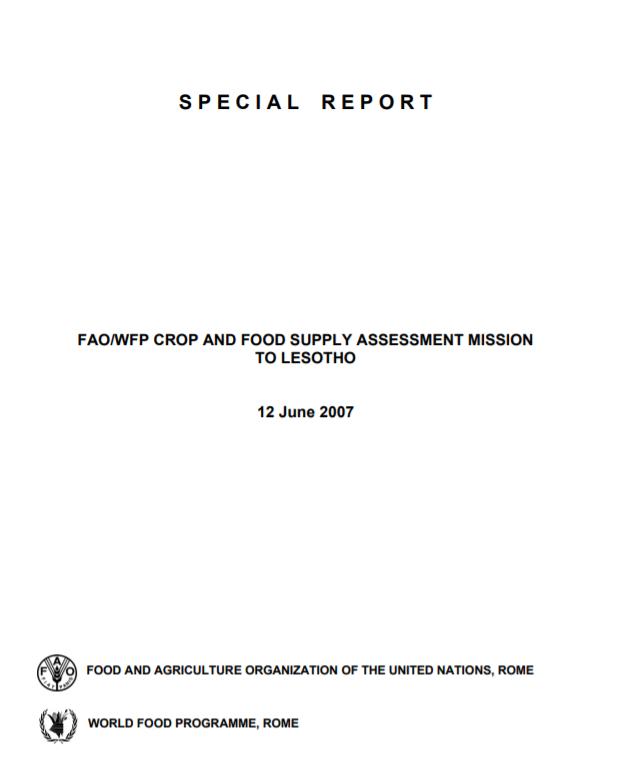
Special Report - FAO/WFP Crop and Food Supply Assessment Mission to Lesotho - 12 June 2007
12/06/2007
Due to the accentuated drought conditions prevailing during the cropping season, the Government of Lesotho requested FAO and WFP to carry out a Crop and Food Supply Assessment (CFSAM) in order to estimate the 2007 cereal production, assess the overall food availability and forecast import requirements for the coming marketing year 2007/08 (April to March), including food assistance needs. The mission visited the country from 22 April to 5 May 2007.
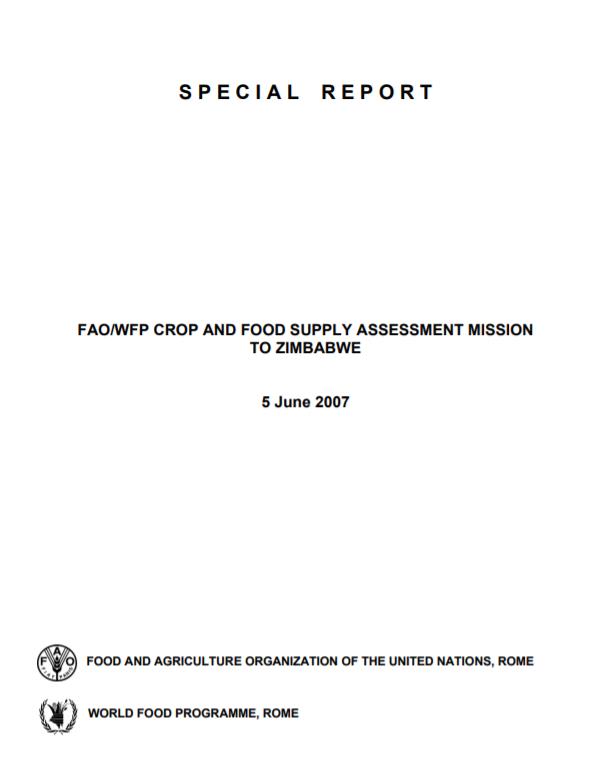
Special Report - FAO/WFP Crop and Food Supply Assessment Mission to Zimbabwe - 5 June 2007
05/06/2007
Zimbabwe experienced severe dry spells and generally unfavourable rainfall during the 2006/07 cropping season, compounding devastating effects of the unprecedented decade-long economic decline. Half-way through the season the Government had declared 2007 as a drought year. Against this backdrop an FAO/WFP Crop and Food Supply Assessment Mission was invited by the Government to visit the country from 25 April to 18 May 2007 to estimate the 2007 production of the main cereals and pulse crops, assess the food security situation in the country and determine the food import requirement, including food assistance needs, for the current marketing year 2007/08 (April/March).
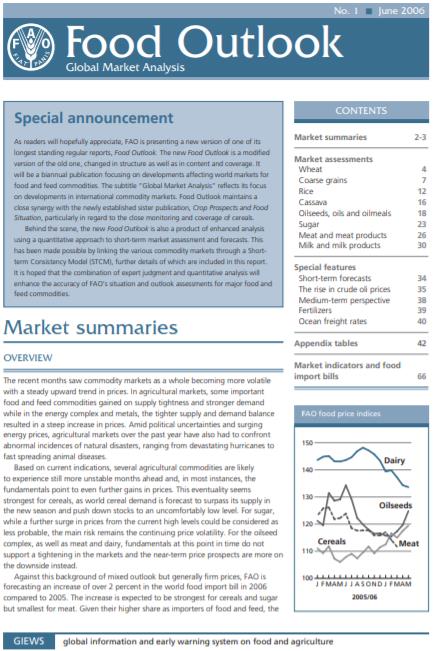
Food Outlook - June 2007
04/06/2007
Based on FAO’s latest analysis, global expenditures on imported foodstuffs look set to surpass US$400 billion in 2007, almost 5 percent above the record of the previous year. The bulk of the increase can be levelled against rising prices of imported coarse grains and vegetable oils, the commodity groups which feature most heavily in biofuel production. Import bills for these commodities are forecast to rise by as much as 13 percent from 2006. More expensive feed ingredients will lead to higher prices for meat and dairy products, raising the expenditures on imports of those commodities. In several cases, such as meat and rice, the import bills are likely to be driven higher also because of larger world purchases. On the other hand, in the case of sugar, generally high and volatile prices could lead to smaller import volumes, the net effect of which is likely to be a drop in the cost of global sugar imports. The rise of international freight rates to new highs also affected the import value of all commodities, putting additional pressure on countries’ ability to cover their food import bills.
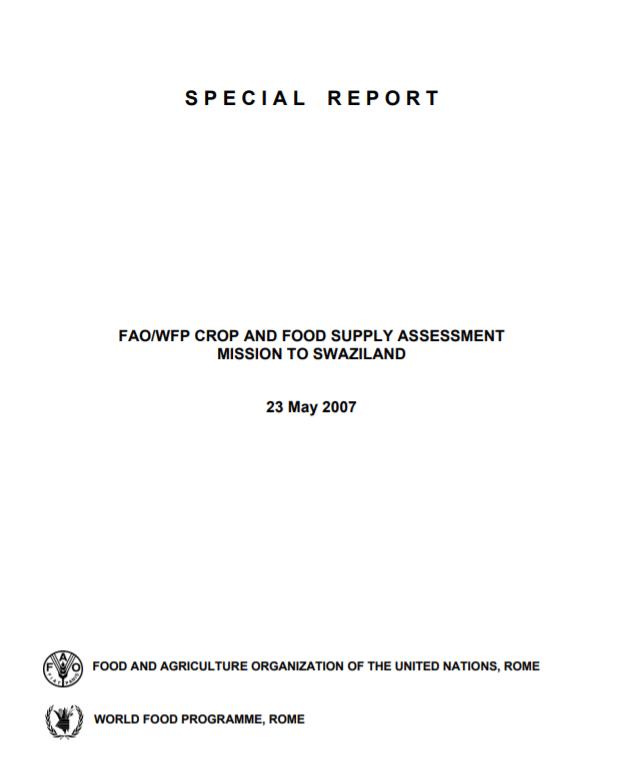
Special Report - FAO/WFP Crop and Food Supply Assessment Mission to Swaziland - 23 May 2007
28/05/2007
An FAO/WFP Crop and Food Supply Assessment Mission visited Swaziland from 8 to 22 April 2007 to estimate the 2006/07 maize harvest and import requirements – including food assistance – for the 2007/08 marketing year (April/March).
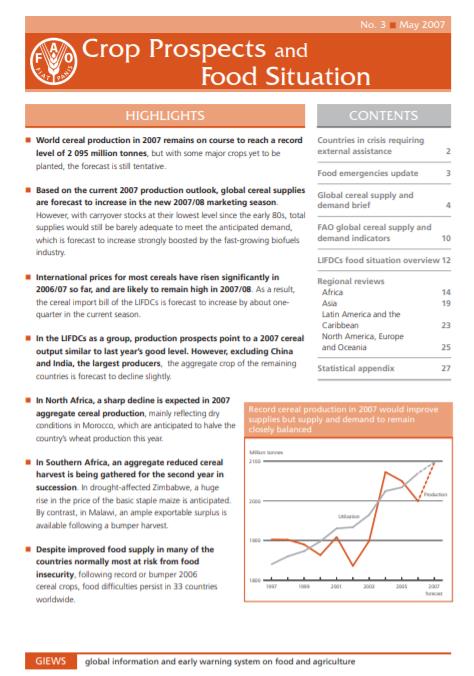
Crop Prospects and Food Situation #3, May 2007
10/05/2007
World cereal production in 2007 remains on course to reach a record level of 2 095 million tonnes, but with some major crops yet to be planted, the forecast is still tentative. Based on the current 2007 production outlook, global cereal supplies are forecast to increase in the new 2007/08 marketing season. However, with carryover stocks at their lowest level since the early 80s, total supplies would still be barely adequate to meet the anticipated demand, which is forecast to increase strongly boosted by the fast-growing biofuels industry. International prices for most cereals have risen signifi cantly in 2006/07 so far, and are likely to remain high in 2007/08. As a result, the cereal import bill of the LIFDCs is forecast to increase by about onequarter in the current season. In the LIFDCs as a group, production prospects point to a 2007 cereal output similar to last year’s good level. However, excluding China and India, the largest producers, the aggregate crop of the remaining countries is forecast to decline slightly.
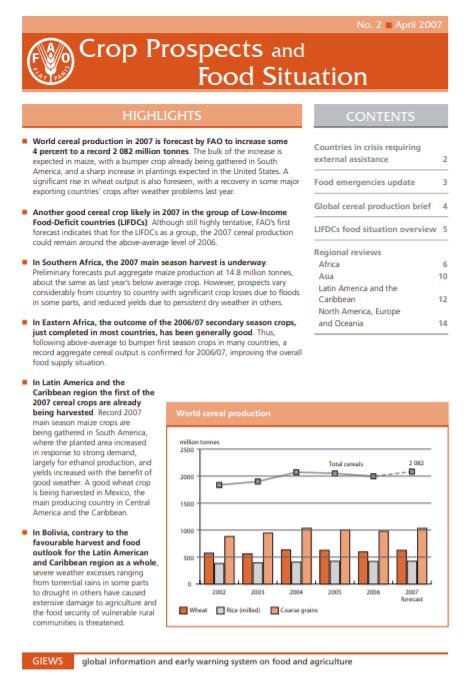
Crop Prospects and Food Situation #2, April 2007
05/04/2007
World cereal production in 2007 is forecast by FAO to increase some 4 percent to a record 2 082 million tonnes. The bulk of the increase is expected in maize, with a bumper crop already being gathered in South America, and a sharp increase in plantings expected in the United States. A significant rise in wheat output is also foreseen, with a recovery in some major exporting countries’ crops after weather problems last year. Another good cereal crop likely in 2007 in the group of Low-Income Food-Deficit countries (LIFDCs). Although still highly tentative, FAO’s first forecast indicates that for the LIFDCs as a group, the 2007 cereal production could remain around the above-average level of 2006.
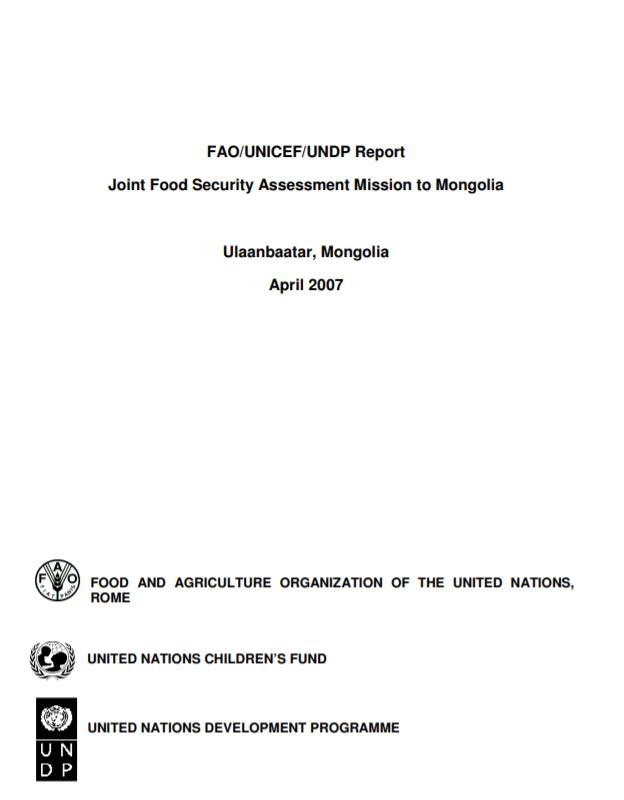
Special Report - FAO/UNICEF/UNDP Report Joint Food Security Assessment Mission to Mongolia
01/04/2007
At the request of the Ministry of Food and Agriculture of Mongolia (MoFA), a UN Joint Food Security Assessment Mission visited the country from 2 to 20 October 2006. The Mission was composed of FAO, UNICEF and UNDP experts and worked in close collaboration with national counterpart partners. The overall objective of the assessment was to have a better understanding of food security at national, sub-national and household levels and to make recommendations on activities to address food insecurity. The major components of the Mission included a two-day Technical Consultation on Food Security in Ulaanbaatar (UB) and the assessment of the food security situation using rapid appraisal techniques. The Mission held meetings with relevant institutions, including Government, international agencies, donors, NGOs and the private sector, and reviewed available data and information on food security from different sources. Field trips to selected aimags (provinces) and soums (districts) were organized in four teams covering: 1) Central provinces (Selenge, Darham, Orhon) and “Ger”1 districts of UB; 2) Western provinces (Uvs and Bayan Olgii); 3) Highlands provinces (Houvsgol, Bulgan and Arkahngai) and 4) Gobi provinces (Dungobi). Overall, the Mission covered 9 aimags and the capital city. During the field visits the Mission met with representatives of the public and private sectors, including traders. In all locations the Mission visited markets and shops, health facilities and schools. Extensive household interviews were conducted in aimag and soum centres, as well as with herder and farmer households in the countryside. Prior to its departure, the Mission had debriefing sessions with Government authorities and UN agencies in the country.
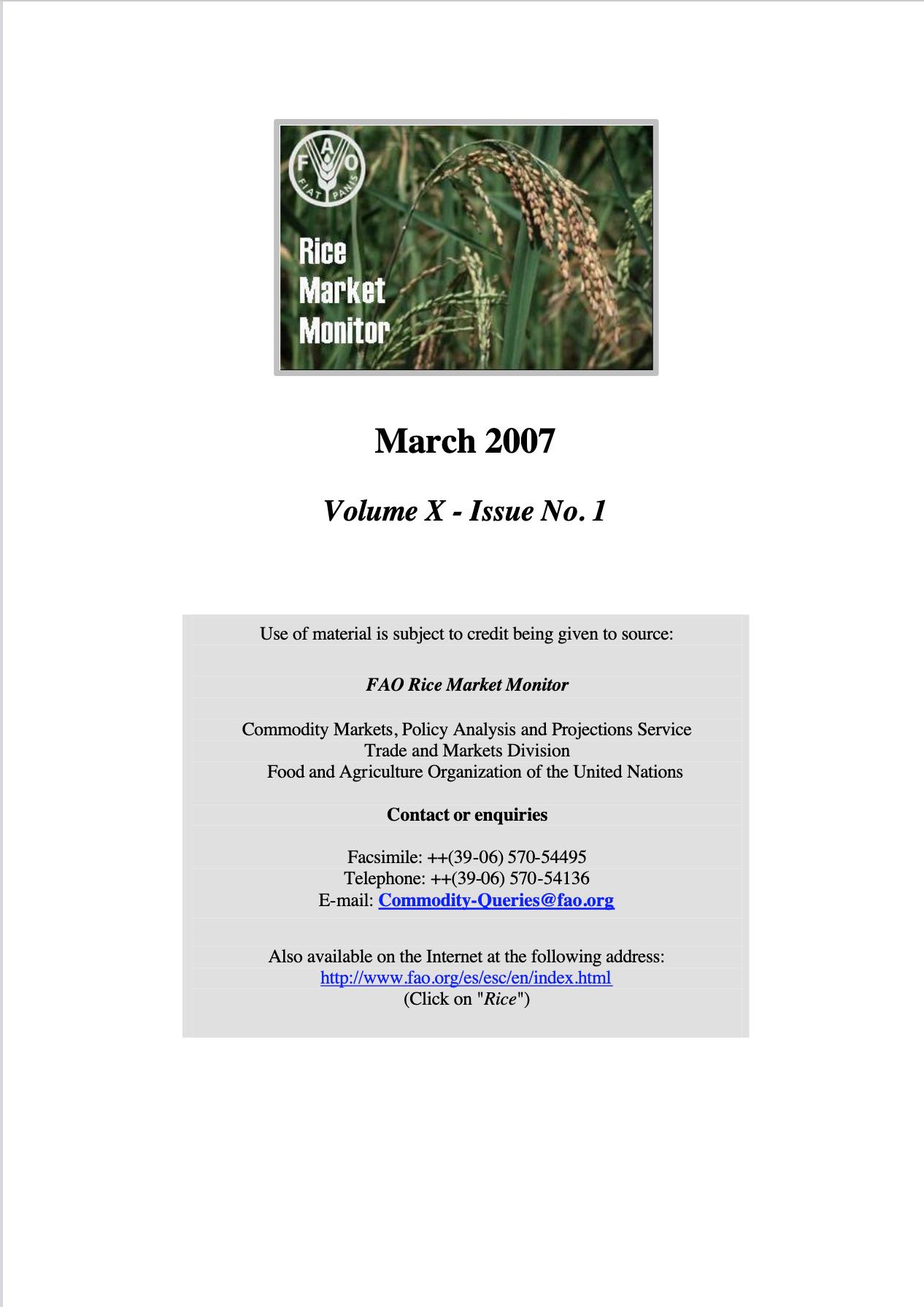
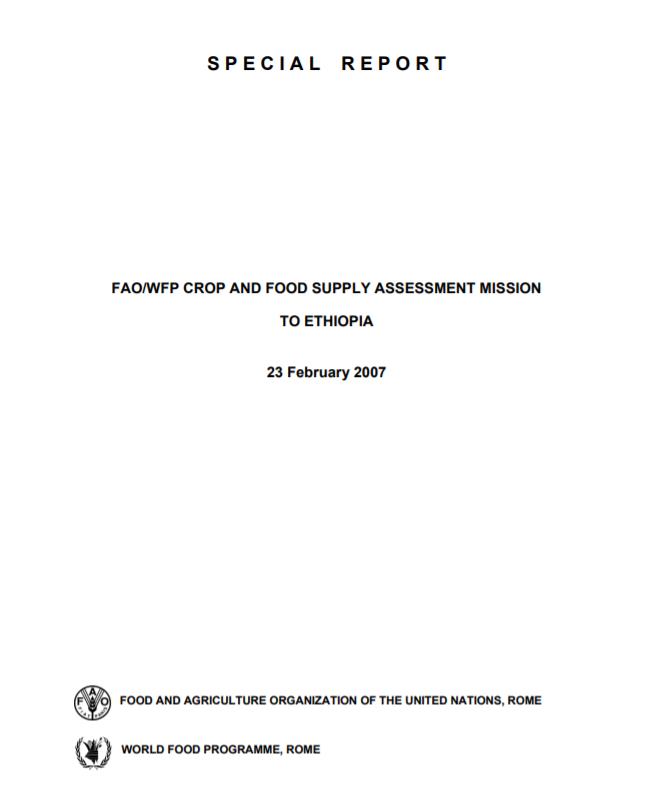
Special Report - FAO/WFP Crop and Food Supply Assessment Mission to Ethiopia - 23 February 2007
23/02/2007
An FAO/WFP Crop and Food Supply Assessment Mission visited Ethiopia from 12 November to 8 December 2006 to estimate the main meher season cereal and pulse production; review the final estimates of the 2005 main meher season and 2006 secondary belg season harvests; forecast the 2007 belg season production; and assess the overall food supply situation for the 2007 marketing year (January/December). Accompanied by experts from the Ministry of Agriculture and Rural Development, the Central Statistics Authority (CSA) and by observers from the European Commission and USAID, the Mission, with seven teams, visited sixty-three zones and special woredas (districts), over an 18-day period, in all the grain producing regions. In addition, helicopter overflights of the Gode and Afder zones, in Somali region, were carried out at the end of the field work.
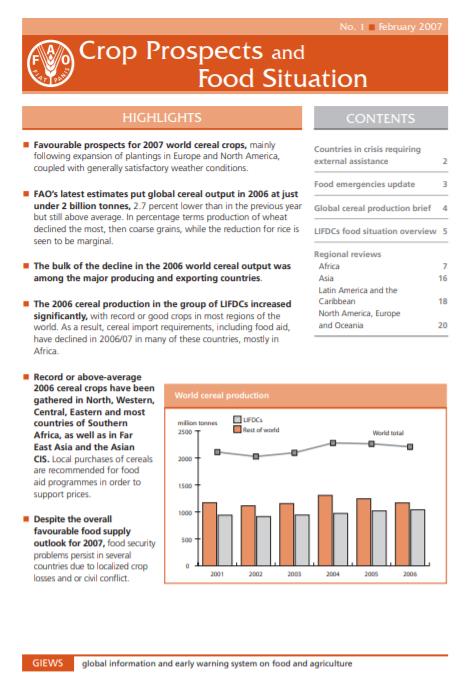
Crop Prospects and Food Situation #1, February 2007
08/02/2007
Favourable prospects for 2007 world cereal crops, mainly following expansion of plantings in Europe and North America, coupled with generally satisfactory weather conditions. FAO’s latest estimates put global cereal output in 2006 at just under 2 billion tonnes, 2.7 percent lower than in the previous year but still above average. In percentage terms production of wheat declined the most, then coarse grains, while the reduction for rice is seen to be marginal. The bulk of the decline in the 2006 world cereal output was among the major producing and exporting countries. The 2006 cereal production in the group of LIFDCs increased significantly, with record or good crops in most regions of the world. As a result, cereal import requirements, including food aid, have declined in 2006/07 in many of these countries, mostly in Africa.
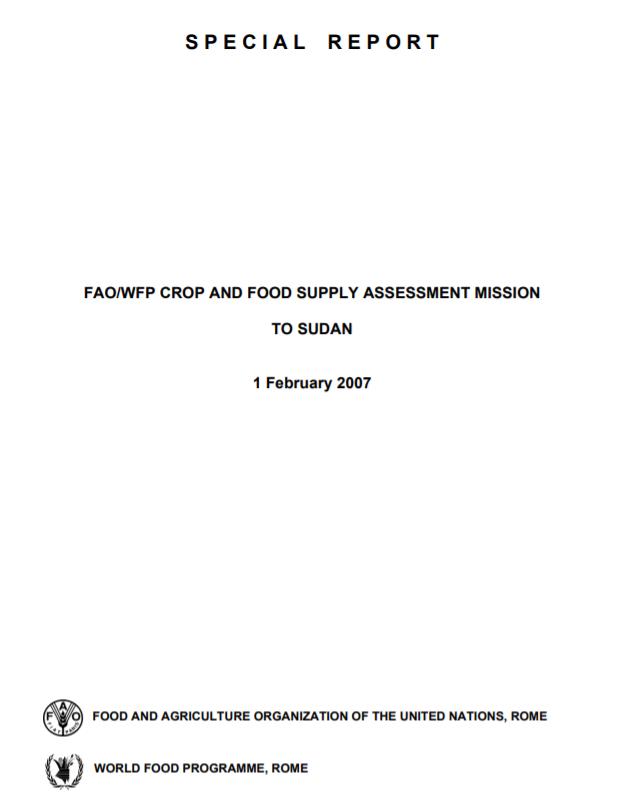
Special Report - FAO/WFP Crop and Food Supply Assessment Mission to Sudan - 1 February 2007
01/02/2007
An FAO/WFP Crop and Food Supply Assessment Mission visited southern Sudan from 7 to 29 October 2006 and northern Sudan from 11 November to 5 December 2006 in order to assess the current season’s cereal production, forecast wheat production from areas prepared for planting, and estimate cereal import requirements for the marketing year 2006/07 (November/October). The Mission in both northern and southern Sudan received the full cooperation from all concerned Government Authorities. The Mission included representatives from the Federal Ministry of Agriculture, the Ministry of Agriculture and Forestry (MoAF) of the Government of South Sudan (GOSS), Humanitarian Aid Commission (HAC) and the Strategic Reserves Cooperation. The Mission was accompanied by EC and USAID observers and benefited from a wide range of discussions with both national and international stakeholders.
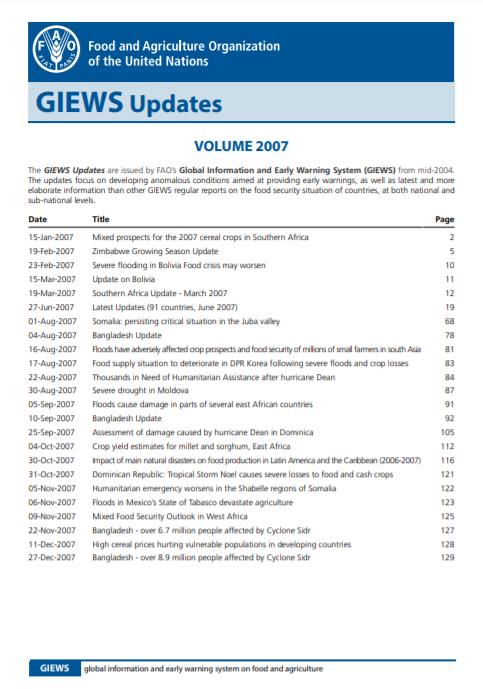
GIEWS Updates - Volume 2007
15/01/2007
The GIEWS Updates are issued by FAO’s Global Information and Early Warning System (GIEWS) from mid-2004. The updates focus on developing anomalous conditions aimed at providing early warnings, as well as latest and more elaborate information than other GIEWS regular reports on the food security situation of countries, at both national and sub-national levels.
